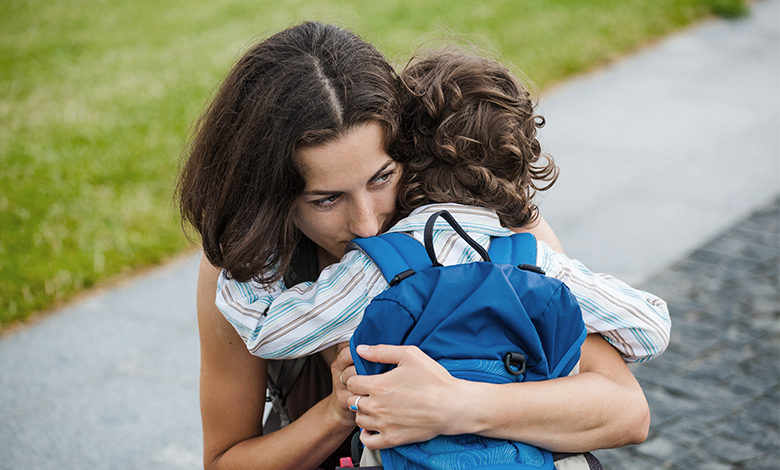- Research, plan and tour facilities to find the best option for you
- Prepare and label everything you need in advance
- Remember that big emotions are normal for both you and your child
5 tips on easing the transition to day care

Key points
Whether you’re returning to work or just taking some time for yourself, sending your little one to day care is a momentous occasion for all parties involved. It’s your child’s first little step into the world without you, and that can be a source of big emotions (on both sides). Here are 5 simple tips for making the transition to day care as smooth as possible.
1. Do your research
Finding a childcare provider that works for you is the most significant step when it comes to easing your child into day care. There’s no one-size-fits-all solution; every parent’s (and child’s) needs are different. Start your research early and don’t rush into anything. Take the time to explore and tour a few options to get a feel for the facilities around you. As well as proximity, cost and availability, you should also think about the style of care that would suit your child’s temperament. Perhaps your little one would be better suited to family day care in a home-based environment, or they might feel more comfortable in a larger day care facility that offers a lot of structure.Next, meet – and spend some time with – the people who’ll be caring for your child. After all, you’re potentially going to be trusting them with the most precious thing in the world. Ensure you’re asking plenty of questions and listen to your gut.
2. Do a trial run
Most childcare services will encourage you to hang around for an orientation session with your child. Considering they’ll be spending a significant amount of time there, familiarising your little one with the environment will go a long way to making them feel more comfortable when they arrive for the real deal.Stick around, introduce them to the staff, and maybe get on the floor with them and play with some of the toys. Model a positive attitude towards day care so your child understands that it is a happy – not daunting – place.
3. Get organised
The last thing you want to be doing the morning of your first drop-off is scrambling to gather all the gear your child needs for the day. The evening before the big day, take some time to write a simple checklist of everything you need: nappies, dummies, wipes, water bottle, clothes, sleep toys, bottles and more. Don’t forget to label all your items, as well. Things can get mixed up quickly with so many little hands and minds involved all day!
4. Anticipate behavioural changes
While some children will have no issues at all making the transition to day care, don’t be surprised if you notice some changes in your little one’s demeanour – especially at drop–off time. If they’re exhibiting signs of separation anxiety, know that this is a common reaction that will likely resolve itself with time.If anxious behaviour persists after the first few weeks, make it a habit to contact the day care centre after drop-off and see if it continues after you leave. If it does, try to work collaboratively to find a solution that eases some of the stress on all of you. Provide as much information as possible to your care providers, including habits, routines, likes and dislikes. Also, try not to stress too much if they get sick – think of it as building their immune defences.
5. Be resilient
Research shows children who are securely attached to their caregivers show more curiosity, self-reliance and independence, and tend to become more resilient adults. But that doesn’t mean you won’t find your own capacity for resilience tested. Separation anxiety is a two-way street, and it’s natural to feel lonely as your little one steps into the world without you.Stay in tune with your emotions and recognise that it’s OK to feel unsettled or sad. Prioritise self-care during this time and try and tap into simple activities or rituals that you can enjoy with some new-found personal freedom. Don’t feel guilty if you find yourself enjoying some downtime, too. Remember that everything you’re doing is hard work, and you deserve to have an opportunity to unwind.
Related pages

Get in touch with our Careline experts
When your little one is unhappy or unwell you want reliable support from a trusted source. Our Careline team of nutritionists, dietitians and midwives specialise in infant and child health, offering free nutrition, feeding and product information.
Every feeding journey is unique
Not every parent can produce breast milk. No matter what choice you make, we will support your unique feeding journey.
We at Nutricia believe in providing the best nutrition for babies, which is why we recognise breast milk is uniquely superior for babies as it provides many benefits. It is important that mums have a healthy diet to support breastfeeding. A decision not to breastfeed, or partial bottle feed, may reduce breast milk supply making it difficult to reverse. The cost and social implications of using feeding methods should be considered. Always seek professional advice about feeding your baby. Ensure formula is used as directed as improper use can affect baby’s health.
REMEMBER: The information on this page is general only. If you have any concerns about your baby’s poo or questions about constipation or any other health concerns, please speak to a healthcare professional, like a Pharmacist, GP or Maternal Child Health Nurse.



